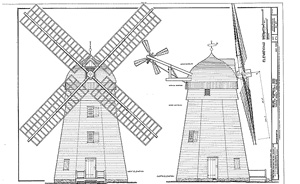talking history | syllabi | students | teachers | puzzle | about us
Built in America: Historic American Buildings Survey/Historic American Engineering Record, 1933-Present
http://memory.loc.gov/ammem/collections/habs_haer/
Created and maintained by the Library of Congress American Memory Project.
Reviewed Jan. 2007.
In 1933, during the depression, the Historic American Buildings Survey (HABS) was established as a national repository for drawings and photographs of early American architecture. The program was administered by the National Park Service, which hired underemployed architects to record and photograph buildings dating from before the Civil War. In a cooperative arrangement, the measured drawings, photographs, and historical data sheets derived from that fieldwork became part of the collections of the Library of Congress. By the 1950s, the HABS, augmented in later years by the Historic American Engineering Record (HAER), was no longer a relief program but a training ground in research and recording practices for students. Over the last fifty years the scope has expanded to include a wider variety of buildings and structures as well as ones from the late nineteenth and twentieth centuries.

Built in America: Beebe Windmill, Bridgehampton, New York.
The accumulated record of seventy-five years in the field is both prodigious and priceless. Lodged in the Prints and Photographs Division of the Library of Congress are more than 350,000 measured drawings, photographs, and short histories of more than 35,000 sites throughout the country, a number of which have been destroyed since they were recorded by a HABS team. Outside some state catalogs and published lists of sites, few of which were thoroughly illustrated, the only way to examine the contents of the HABS/HAER collection was to visit the Prints and Photographs Division Reading Room armed with rolls of small change to photocopy the files. Though this did not deter scholarship, it did take some planning for those outside Washington, D.C.
The effort to digitize the collection and make it accessible online has proven a boon to those who know the collection, and it will invite greater use among architects, preservationists, and historians searching for information about individual sites or specific types of structures or features. The HABS/HAER archives can be searched by subject or by location, providing, for example, a list of the 106 buildings across the country described as meetinghouses or the 139 sites recorded in Savannah, Georgia. Open any of those pages, and there is generally a full set of reduced measured drawings (plans, elevations, sections, and details), black-and-white photographs, and historical data sheets, all of which are available at a high resolution for printing, although there are glitches, as some of the photographs resolutely refuse to appear on the screen. New users of this material should be aware of shortcomings in what they find. For example, much of the information on the data sheets is obsolete, buildings are sometimes misdated, and most drawings are not interpretive. But with those caveats understood, this is a marvelous source at one’s fingertips. Countless hours of searching books for plans of particular building types or looking for illustrations to compare the framing details of buildings in different parts of the country vanish with a few minutes of careful browsing.
Carl R. Lounsbury
Colonial Williamsburg Foundation
Williamsburg, Virginia
